 |

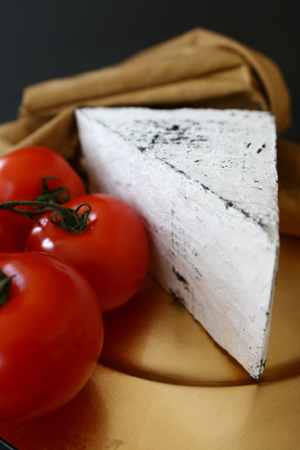
Mount McKinley, an award-winning shepherd’s-style aged cheese, is a chèvre unfamiliar to most people: sharp, earthy and nutty. Enjoy it as a table cheese with red wine, shaved on a salad, grated on pasta or in a risotto. Photos by B.A. Van Sise. |
| WHAT IT IS: Award-winning goat cheeses from Napa Valley that are as delicious as anything from France. |
WHY IT’S DIFFERENT: Cheeses are made in every style, from fresh goat fromage blanc to a classic pyramid and crottins to goat cheddar, a Gouda-style and hard cheeses to grate over risotto and pasta. |
| WHY WE LOVE IT: There’s good goat cheese and there’s great goat cheese. These are heavenly goat cheeses. The goats—and cheesemakers—must have halos. |
WHERE TO BUY IT: CypressGroveChevre.com
and fine cheese stores |
|
|
 |

Cypress Grove Chevre:
Got Your Goat!

CAPSULE REPORT: To some, happiness is a warm puppy. To others, it’s a shipment of perfect goat cheeses—called chèvre in French—from California’s Cypress Grove Chevre. From a goat fromage blanc we never want to be without, to the most lush and lovely fresh cheeses, to the aged Mount McKinley triangle that can be grated over pasta and risotto or enjoyed, like Parmigiano-Reggiano with a fine red wine, Cypress Grove demonstrates why one no longer needs to go to Europe for a brilliant cheese experience.
Cypress Grove also makes the iconic Humboldt Fog, a cheese that, in earlier centuries, might have inspired sonnets and songs. Many people like to give gifts of chocolate or wine. Give someone an assortment of the three-inch fresh cheese disks and a one-pound Humboldt Fog, and happiness ensues for breakfast, lunch and dinner. Maybe some singing, too. Read the full review of Cypress Grove Chevre below, and go get your goat!
|
THE NIBBLE does not sell the food products we review or receive fees from manufacturers for recommending them. Our recommendations are based purely on our opinion, after tasting thousands of products each year, that they represent the best in their categories. |
Books For Turophiles (Cheese Lovers)
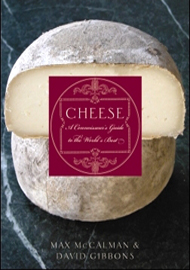 |
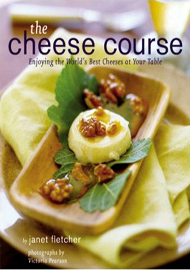 |
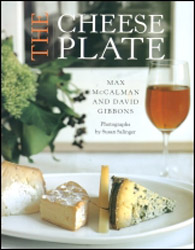 |
| Cheese: A Connoisseur’s Guide to The World’s Best, by Max McCalman. Maître Fromager McCalman profiles 200 of the world’s very best cheeses from A (Aarauer Bierdeckel) to Z (Zamorano). A wonderful book, complete with all the practical information and fascinating details a connoisseur could want. Click here for more information or to purchase. |
The Cheese Course, by Janet Fletcher. It’s more than 4 hunks of cheese on a wooden board: learn how to prepare stunning and imaginative cheese courses that can be the highlight of an otherwise simple meal. The good news is that it’s relatively simple to do it—you don’t even have to know how to cook! This book is also a great gift for anyone who loves to entertain. Click here for more information or to purchase. |
The Cheese Plate, by Max McCalman. Dean of Curriculum and Maître Fromager at Artisanal Premium Cheese Center and School in New York City, McCalman has produced a wonderful book. It includes perhaps the best-published information about pairing cheese and wine. Click here for more information or to purchase. |
Cypress Grove Chevre: Got Your Goat
France is the homeland of goat cheese, with more goat cheeses and more domain-protected goat cheeses* than any other country. People in the cheese world often use the French word for goat and goat cheese, chèvre. For many years, before the artisan food movement in California and elsewhere created fine American cheesemakers, the place for goat cheese-lovers to go was France. We know: We were one of the chèvre-starved who arrived each year to eat our fill of great chèvre and baguette.
*Of the 40 French cheeses with A.O.C. status, 12 are chèvre: Banon (2003), Cabecou (1988), Chabichou du Poitou (1990), Chevrotin des Aravis (2002), Crottin de Chavignol (1976), Pélardon des Cevennes (2000), Picodon (1983), Puligny Saint Pierre (1972), Rocamadour (1996), Sainte-Maure de Touraine (1990), Selles sur Cher (1975) and Valençay (1998).
Not being Californians, we didn’t know about Cypress Grove Chevre†. In 1983, Mary Keehn, a mother of four young daughters, set out to make cheeses as exceptional as those that can be enjoyed in France or anywhere else a goat roams. The cheeses have been recognized many times over with national and international awards. Online bulletin boards extol the virtues of Cypress Grove cheeses. The painstaking efforts in both pasture and creamery are evident in every bite.
†The company does not use the French grave accent mark on its name or its cheeses; we have used the accent in all other instances.
Great cheese starts with great milk. Cypress Grove’s milk comes from goats who live on family farms and graze in the lush pastures and the mild climate of Humboldt County on the north coast of California, approximately 200 miles north of San Francisco and 410 miles south of Portland, Oregon. Ample rainfall and fertile soil contribute to verdant pastures with nutritious grasses. The lush carpet of grass for grazing results in milk that is high is butterfat and protein—essential building blocks for great cheese. The terroir is especially evident in the Fresh Cheeses.
The cheesemakers create both traditional-style cheeses and break tradition with some good old American innovation. From the fresh, mild, lemony, spreadable Fresh Chevres to the nutty, complex aged chèvres that can be sliced and grated on pasta, there’s a Cypress Grove Chevre for every palate (including palates who think they don’t like chèvre).
The Cypress Grove website suggests wine pairings, and offers recipes, for each type of cheese.
Cypress Grove Fresh Cheeses
Most people who love goat cheese have a special fondness for the light and tangy fresh cheeses with their lilt of lemon. The cheeses are meant to be eaten fresh: Don’t buy more than you plan to consume in a week. Wrap leftovers tightly in plastic wrap and keep them in the coldest part of the refrigerator—which is at the back, never on the door.
Fromage Blanc. This celestial curd is an epiphany of goodness: soft, spreadable, the consistency of ricotta with the tang of sour cream. We’ve been enjoying it for two weeks, every day, every meal: on toast and bagels, with fruit, with tea sandwiches, as a dip, on baked potatoes. High in flavor, low in fat compared to similar spreadable cheeses, it also freezes beautifully.
Fresh Chevre. These traditional 3-inch disks look too cute to eat, but warning: After your first bite, they will disappear faster than UFOs. The Natural (plain) is plenty tasty, but the addition of herbs and spices makes for spectacular flavors in Chive, Dill, Herb (herbes de Provence‡), Pepper and Purple Haze (lavender and wild fennel pollen). The Natural is also available in chèvre logs which can be sliced into medallions for salads.
‡Generally a mixture of thyme, bay leaf, rosemary, savory and basil, although other herbs can be added by the blender.
Serving Suggestions
Breakfast
|
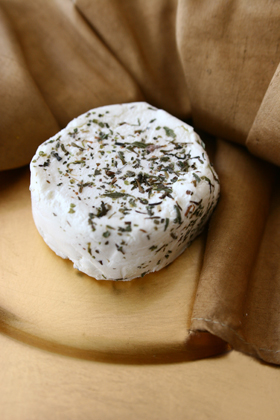
Fresh Chevre with herbes de Provence.
|
- Bread Spread: Spread any Fresh Chevre or fromage on toast with marmalade. Use Fromage Blanc instead of cream cheese on a bagel.
- Crepes & Blintzes: Sweeten Fromage Blanc to fill crepes and blintzes, or to top pancakes, waffles and French toast.
- Green Salad: Cut a slice and serve in the center or at the side of mesclun, arugula, or other soft greens. You can roll the log in toasted nuts and herbs of your choice—or just seasoned breadcrumbs—then cut to single serving slices. Broil or sauté the slices for a few moments to warm, and serve in the center of the salad.
- Citrus Salad: Use fromage blanc instead of cottage cheese or yogurt; fold minced garlic and Herbs de Provence into Fromage Blanc. Stuff mixture into mushroom caps and broil for just a moment.
Dinner
- Hors d’Oeuvre: same as before. Flavor Fromage Blanc with herbs or pesto. Use as a dip for veggies or chips. Fold minced garlic and Herbes de Provence into Fromage Blanc or use fresh Cheeses. Stuff mixture into mushroom caps and broil for just a moment.
- First Course: For a beautiful first course, wrap the log with cold grilled eggplant, red roasted peppers, and steamed red chard leafs. Slice, warm, and serve.
- Pasta: Chop and add a Fresh Chevre disk to chopped tomatoes, 1/3 cup chopped fresh basil, and pasta. Toss and serve. Or, crumble a log over hot pasta and add your choice of chicken, broccoli, smoked salmon, grilled vegetables, etc.; toss to melt the chèvre. Make a sauce of Fromage Blanc simply by tossing over pasta; or use it instead of ricotta in lasagna recipe and ravioli.
- Dessert: Make Brandy Crème by combining one pound of Fromage Blanc with ½ cup whipped cream and 2 tablespoons of brandy, Amaretto or other liqueur. Chill and serve in individual ramekins, or use to top berries or fruit salad, crepes or blintzes.
Snacks, Tea & Hors d’Oeuvres
- Cheese & Crackers: Place any of the Fresh Chevre disk in the center of a serving plate and surround with a circle of chopped olives. Drizzle liberally with olive oil. Serve with thin slices of baguette or fancy crackers.
- Ginger Chèvre: Take a Natural Fresh Chevre disk or medium slices from a log, and press with pieces of crystallized ginger. Serve with ginger snaps, wheatmeal biscuits, graham crackers or water biscuits and chai or other spiced tea.
Cypress Grove Ripened Cheeses
This lovely group of handcrafted cheeses appeals to the eye as well as the palate. These are great cheeses for any cheese plate—but try topping a burger with a slice (hamburger or lamburger: goat cheese and lamb are a great pairing). Always wrap ripened cheese in waxed paper or butcher paper—not plastic wrap. They need to breathe.
- Humboldt Fog, Cypress Grove Chevre’s signature cheese, is one of the iconic goat cheeses in America with many awards to its credit (photo at right). Creamy and elegant, with a subtle tangy flavor, it is known for its ribbon of edible vegetable ash along its center and a coating of ash under its exterior to that give it a distinctive, cake-like appearance. The cheese provides gustatory contrasts in its creamy paste, tasty bloomy mold rind, and a tangy layer** that buffets the two and a lemony finish. Some call Humboldt Fog cake-like—and for these reasons, we certainly agree.
**This is called proteolysis: The milk proteins are being digested by enzymes in the white bloomy rind, as the mold in the rind digests the cheese from the outside. The more aged the cheese, and the warmer it has been kept, the larger the layer of proteolysis.
- Bermuda Triangle was made for presentation: The unusual triangular shape stands out on a cheese plate or fruit platter. It ripens differently from Humboldt Fog, mild but a bit earthier and without the citrus finish. When you slice it, there are three concentric triangles: the rind, the proteolysis and the paste in the center. A winner of several American Cheese Society First Place awards.
- Fog Lights is a similar cheese to Humboldt Fog in a classic crottin shape (photo at right), without the center layer of ash. Like Humboldt Fog, it is ash-covered and mold-ripened, has great, earthy flavor and a lovely texture. It’s perfect for a cheese plate after dinner with toasted nuts and fresh fruit.
|
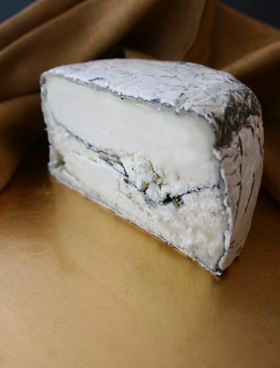
Humboldt Fog, above, is a goat-cheese-lover’s passion:
a beautiful cheese to look at as well as to enjoy. A two-time Gold Medal Winner at the World Cheese Awards in London (including 2007).
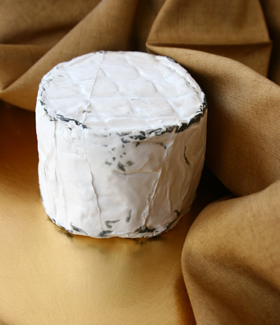
Turn on the lights: Fog Lights, above, is an ash crottin
that always makes us want to ash for more.
|
- Mad River Roll, named for the Mad River that flows near the creamery, is a three-inch diameter ripened log that becomes richer and creamier near the center. You can cut large, gorgeous slices that look tantalizing on a salad or a buffet.
- Pee Wee Pyramid (photo below) reminds us of our first, eye-opening French goat pyramids—and tastes every bit as good. Another great-tasting cheese for the cheese board, the pyramid adds great eye-appeal.
Serving Suggestions
Lunch & Dinner
- Salad: Place a slice of cheese atop a salad of spinach, apple, mandarin oranges, walnuts, cranberries, and red bell pepper; drizzle with raspberry-balsamic vinaigrette. Or for just a touch, crumble some cheese over any salad and drizzle with oil and balsamic vinegar.
- Cheese Plate: These cheeses will be a hit on any cheese plate. Or, serve for individually for dessert with honeycomb, pears and a crisp white wine. Use Bermuda Triangle as a standout triangular garnish on a mushroom fettuccine or tagliatelle with a wild mushroom ragù.
- Sandwiches & Burgers: Add a slice for a gourmet touch. Crumble if you like.
- Dessert: Serve with baked apples or baked pears.
- More Recipes: See the recipes on the website for Grilled Black Mission Figs Wrapped in Prosciutto with Humboldt Fog Goat Cheese and Aged Balsamic Vinegar, Humboldt Fog Sandwich, Warm Cabbage & Goat Cheese Salad and Humboldt Fog Cheesecake with Vanilla and Honey-Poached Figs.
Snacks
- Cheese & Fruit: A slice of any of the cheeses with an apple (try a Fuji apple) is a tasty snack at any time of day.
Back to Index
Firm Cheeses
Two delicious firm cheeses offer very different perspectives on what a goat cheese can deliver. Firm cheeses and aged cheeses should be stored tightly wrapped in plastic to prevent them from drying out.
- Goat Milk Cheddar (photo at right) will be a revelation to anyone who thinks that goat cheese is strong. This cheese is so smooth and mellow, it beckoned to the children at hand. We spent much time fending off Goat Milk Cheddar poachers who would have finished off the supply before we finished this article.
- Mt. McKinley (photo at the top of the page), a First Place winner at the American Cheese Society annual competition, is a unique creation in the style of a shepherd’s cheese—the type made high in the mountains while the shepherds tend their flocks and are brought down in the fall when the flocks come in for winter. Aged 6 months to develop complex, earthy flavors, it is a goat’s milk cheese that can be substituted for a cow’s milk parmesan. It’s a completely different cheese, of course, but equally as versatile. It shaves, grates and slices beautifully. As to why it’s named after the huge mountain in Alaska: formidable appearance and flavor a good guess.
|
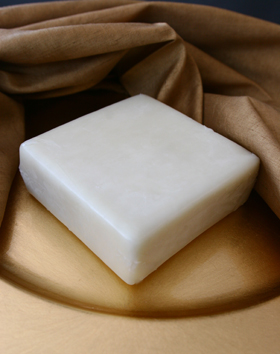
Cheddar lovers can try Goat Milk Cheddar: mild goat
notes in a complex table and cooking cheese.
|
Serving Suggestions
Lunch
- Pizza: Spread fresh pesto over a thin, herbed pizza crust. Top with finely chopped, sautéed vegetables and grated Goat Milk Cheddar. Bake until cheese melts and crust is golden brown.
- Salad: Grate Mt. McKinley over a fresh green bean and heirloom tomato salad.
- Sandwiches: Add sliced Goat Milk Cheddar to sandwiches, make grilled cheese sandwiches or melt in a warmed tortilla. Make an open-faced sandwich with olive bread and tapenade; top with tomato, red onion and a slice of Mt. McKinley; broil and serve.
Dinner
- Pasta: Grate Mt. McKinley and lemon zest over pasta and sprinkle with pine nuts. Make a delicious goat cheddar macaroni and cheese with Goat Milk Cheddar and some gorgeous Italian artisan pasta.
- Risotto: Grate Mt. McKinley over risotto with asparagus and lemon.
Aged Goat’s & Sheep’s Milk Cheeses
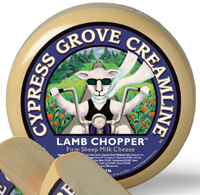 On a trip to Holland, Mary Keehn, founder of Cypress Grove, met some master cheesemakers and worked on some formulations with them. The result is two aged Gouda-style wheels, about 9 pounds in weight, one sheep’s milk, one goat’s milk. Made and aged in Holland, they provide two outstanding options to Cypress Grove fans. The goat is glorious and the sheep is no slouch, either. If you see the entire wheel, you’ll also enjoy the graphics in the wax, conceptualized by Ms. Keehn. While these are Gouda-style cheeses, they are not your grandfather’s Gouda: They’re 21st century spins on great cheeses, punched up with a bit of glamour to appeal to American audiences. On a trip to Holland, Mary Keehn, founder of Cypress Grove, met some master cheesemakers and worked on some formulations with them. The result is two aged Gouda-style wheels, about 9 pounds in weight, one sheep’s milk, one goat’s milk. Made and aged in Holland, they provide two outstanding options to Cypress Grove fans. The goat is glorious and the sheep is no slouch, either. If you see the entire wheel, you’ll also enjoy the graphics in the wax, conceptualized by Ms. Keehn. While these are Gouda-style cheeses, they are not your grandfather’s Gouda: They’re 21st century spins on great cheeses, punched up with a bit of glamour to appeal to American audiences.
- Midnight Moon is a goat’s milk cheese. You’d never know a goat had been near it: It tastes like it was nurtured by pecan trees, a handsome cheese of pure toasted pecan nuttiness, aged a minimum of six months. The wheel is decorated with an illustration of a pretty flapper beckoning you to join her. Since she’s standing in a bucolic setting in broad daylight, we can only infer that the Midnight Moon she wants to share is the cheese—an excellent choice! Serve it with cured meats and fresh fruit, with fig preserves, on a grilled cheese sandwich or for an assertive macaroni and cheese.
- Lamb Chopper, a “youngster” aged 3 to 6 months, is a milder version of Midnight Moon, creamy and lightly nutty. The only non-goat cheese currently sold by Cypress Grove Chevre, it’s a worthy addition to the lineup. The graphic on the wheel is so nifty, we want to own it as art. When you see the lamb riding his chopper through the country road, white scarf flying in the breeze, you know you’re going to have a good time: His theme song is “Born To Be Mild.” Shave some on mushroom and rosemary polenta, over a cantaloupe, mint and prosciutto salad, or enjoy it in a not-so-basic grilled cheese sandwich.
|
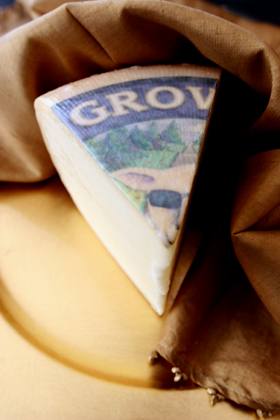 NOT A CHEVRE! You can see the ear and sunglasses of
Lamb Chopper, the motorcycle-riding lamb of this
Gouda-like cheese made in Holland for Cypress Grove Chevre. NOT A CHEVRE! You can see the ear and sunglasses of
Lamb Chopper, the motorcycle-riding lamb of this
Gouda-like cheese made in Holland for Cypress Grove Chevre.
|
How Goat Cheese Is Different
Personal preferences notwithstanding, goat’s milk cheese has some benefits over cow’s milk cheeses. Lower in fat and calories than cow milk cheeses.
- Easier digestibility. Long considered an alternative for those with cow’s milk sensitivities, people who are lactose-intolerant (or otherwise have difficulty digesting milk products) can often enjoy goat cheese.
Goat’s milk has smaller fat molecules that are more easily digested, plus a higher content of fatty acids which makes it especially digestible.
- Lower fat and milk sugar. Goat’s milk also has a higher percentage of short- and medium-chain fatty acids than cow’s milk and is lower in cholesterol. It is higher in calcium, phosphorus, and vitamins A and B. (Goat milk has virtually the same calories as cow’s milk). In comparison to cow’s milk, goat’s milk contains lower fat and milk sugar. These differences are sufficient enough so that many people who have difficulty digesting cow’s milk find that goat’s milk products agree with them.
Compare, for example, Cypress Grove Fromage Blanc and Fresh Chevre to cream cheese. Not only are the goat products better for you—they have added dimensions of flavor that make cream cheese taste very bland indeed. |
| Per One-Ounce Serving |
Cypress Grove
Fromage Blanc or
Fresh Chevre |
Cream Cheese |
| Calories |
70 |
100 |
| Total Fat |
6g |
10g |
| Cholesterol |
15mg |
30mg |
| Sodium |
90mg |
80mg |
| Protein |
4g |
2g |
|
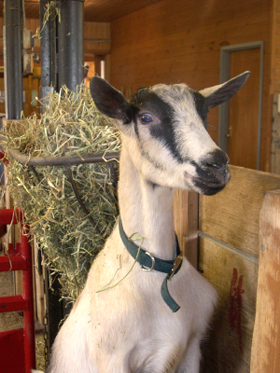 |
Goat’s milk has a distinctive taste. Some say that fresh goat cheese has a flavor reminiscent of mown grass. As the cheese ages, it can develop earthy and nutty flavors. Over-matured cheeses with the tang of ammonia are much prized by certain chèvre fans. People who have not enjoyed stronger goat cheeses speak about its “goatiness,” while those who love chèvre are enraptured by it.
Just as there are strong-tasting cow’s milk and sheep’s milk cheeses, as well as mild ones, it’s likely that there’s a chèvre for every palate. Beginners should first try fresh goat cheeses—especially with a baguette and a crisp white wine.
Read more about chèvre and other goat’s milk products in Parlez-Vous Chevre?
|
It’s spring—and if the thoughts of goats gamboling in the meadow don’t put you in the mood for some exceptional goat cheese, hopefully this review has. Please—order lots of different varieties, to give yourself an overview of what this wonderful dairy produces. Those little goats work hard to produce cheese for you: It takes about one gallon of milk to make just 1.3 pounds of cheese, and does can’t produce more than three gallons of milk a day. Don’t make them maaaad: enjoy their cheese!
—Karen Hochman
FORWARD THIS NIBBLE to people cheese-loving friends—even if they think they don’t like chèvre.
CYPRESS GROVE CHEVRE
Fresh, Ripened and Firm Goat Cheeses and
Aged Sheep Cheeses
- Fresh Chevre Disks (5 Ounces)
$4.75
- Fresh Chevre Logs (11 Ounces)
$8.99
- Fog Lights (8 Ounces)
$10.00
- PeeWee Pyramid (4.5 Ounces)
$6.25
- Bermuda Triangle (16 Ounces)
$17.50
- Humboldt Fog (16 Ounces)
$18.00
- Goat Milk Cheddar (8 Ounces)
$7.75
- Mt. McKinley (16 Ounces)
$17.25
- Midnight Moon (16 OUnces)
$17.25
- Lamb Chopper (16 Ounces)
$18.25
Available at fine cheese stores nationwide, or
purchase online. Retail prices may vary.
|
 |
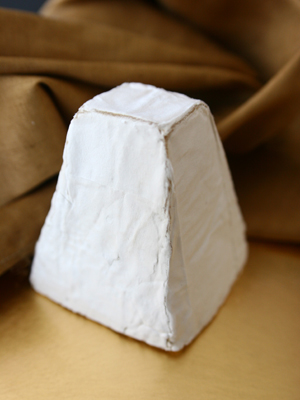
PeeWee Pyramid: a beauty of a chèvre.
Back to Index
Purchase online at ArtisanalCheese.com,
CowgirlCreamery.com, MurraysCheese.com
For more information visit
CypressGroveChevre.com.
|
Read more about our favorite
cheeses and related products
in THE NIBBLE online magazine.

|
Check Out These Other “Top Pick Of The Week” Cheeses:

|
Back to Index
Do you have friends who would enjoy THE NIBBLE?
Click here to send them an invitation to sign up for their own copy.
|
ABOUT THE NIBBLE. THE NIBBLE™, Great Food Finds™, is an online magazine about specialty foods and the gourmet life. It is the only consumer publication and website that focuses on reviewing the best specialty foods and beverages, in every category. The magazine also covers tabletop items, gourmet housewares, and other areas of interest to people who love fine food. This e-mail from the editors features the top food pick of the week. You can read the complete magazine and past issues at TheNibble.com.
© Copyright 2004-2025 Lifestyle Direct, Inc. All rights
reserved. All information contained herein is subject to change at any time
without notice. All details must be directly confirmed with manufacturers, service
establishments and other third parties. The material in this newsletter may not
be reproduced, distributed, transmitted, cached, or otherwise used, except with
the prior written permission of Lifestyle Direct, Inc.
|
 |
|
 |













 On a trip to Holland, Mary Keehn, founder of Cypress Grove, met some master cheesemakers and worked on some formulations with them. The result is two aged Gouda-style wheels, about 9 pounds in weight, one sheep’s milk, one goat’s milk. Made and aged in Holland, they provide two outstanding options to Cypress Grove fans. The goat is glorious and the sheep is no slouch, either. If you see the entire wheel, you’ll also enjoy the graphics in the wax, conceptualized by Ms. Keehn. While these are Gouda-style cheeses, they are not your grandfather’s Gouda: They’re 21st century spins on great cheeses, punched up with a bit of glamour to appeal to American audiences.
On a trip to Holland, Mary Keehn, founder of Cypress Grove, met some master cheesemakers and worked on some formulations with them. The result is two aged Gouda-style wheels, about 9 pounds in weight, one sheep’s milk, one goat’s milk. Made and aged in Holland, they provide two outstanding options to Cypress Grove fans. The goat is glorious and the sheep is no slouch, either. If you see the entire wheel, you’ll also enjoy the graphics in the wax, conceptualized by Ms. Keehn. While these are Gouda-style cheeses, they are not your grandfather’s Gouda: They’re 21st century spins on great cheeses, punched up with a bit of glamour to appeal to American audiences. NOT A CHEVRE! You can see the ear and sunglasses of
Lamb Chopper, the motorcycle-riding lamb of this
Gouda-like cheese made in Holland for Cypress Grove Chevre.
NOT A CHEVRE! You can see the ear and sunglasses of
Lamb Chopper, the motorcycle-riding lamb of this
Gouda-like cheese made in Holland for Cypress Grove Chevre.
